Business Law Report: UK Legal System and Business Forms
VerifiedAdded on 2021/01/02
|15
|4263
|217
Report
AI Summary
This report provides a comprehensive overview of UK business law. It begins with an introduction to the nature of the UK legal system, differentiating between criminal and civil law, and outlining the sources of law, including legislation, common law, European Union law, and the European Convention on Human Rights. The report then delves into the gig economy, contrasting employed and self-employed statuses, and presents the Pimlico Plumbers case to illustrate employment status determination. Furthermore, the report explores various forms of business organizations in the UK, with a specific focus on sole traders, including their advantages and disadvantages. Finally, the report addresses legal solutions to areas of dispute, offering insights into how disputes can be resolved. The report concludes with a summary of the key findings and a list of references.
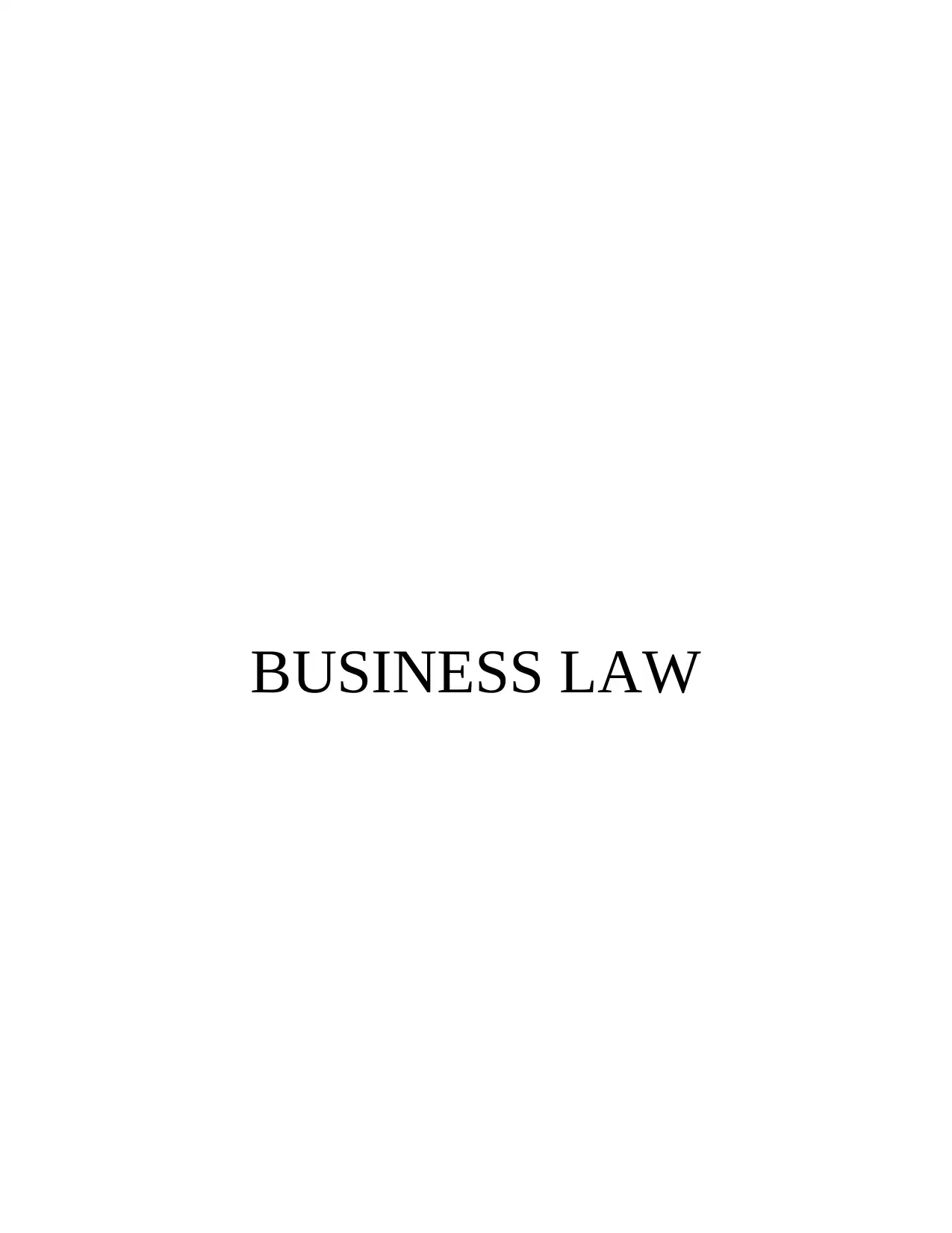
BUSINESS LAW
Paraphrase This Document
Need a fresh take? Get an instant paraphrase of this document with our AI Paraphraser
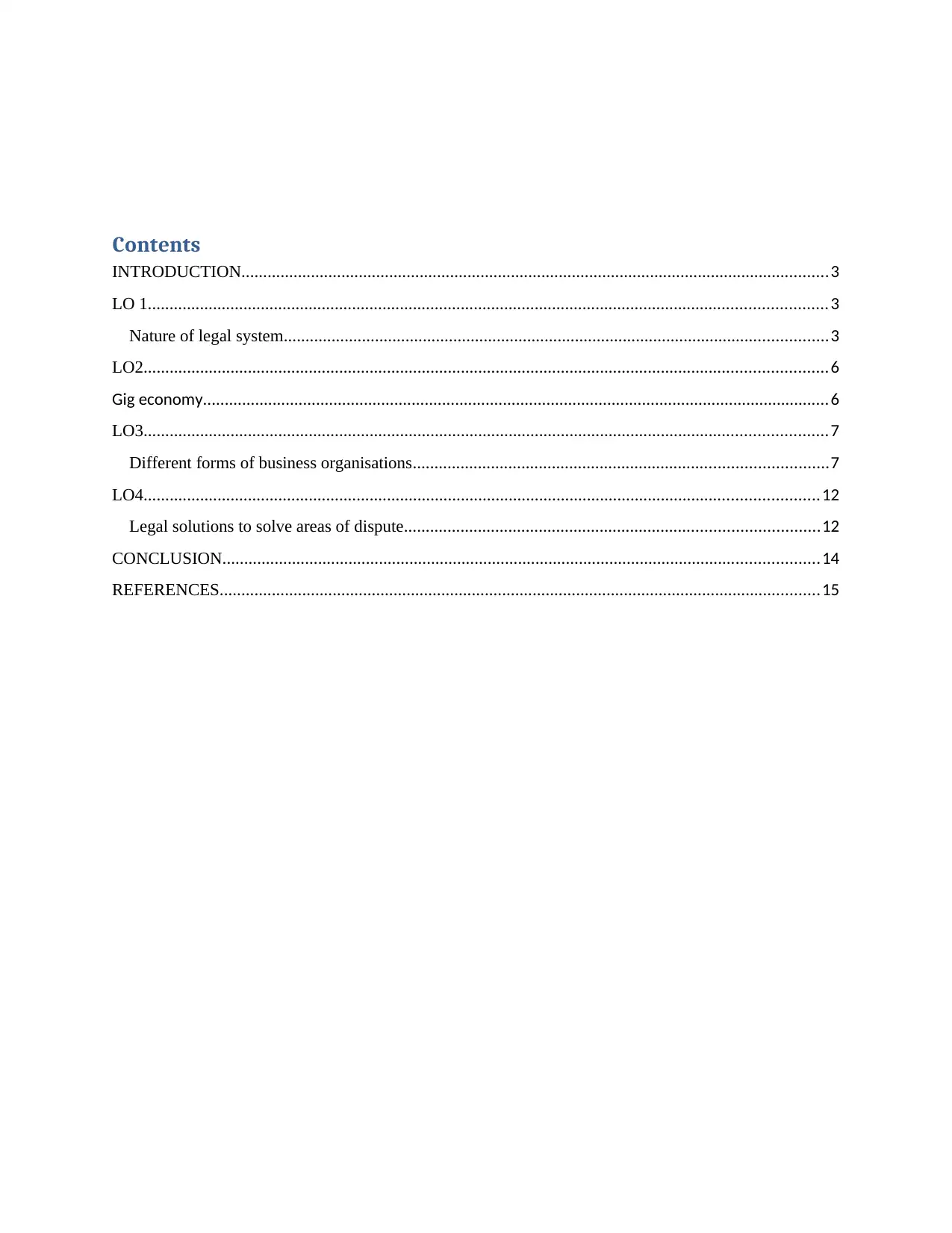
Contents
INTRODUCTION.......................................................................................................................................3
LO 1............................................................................................................................................................3
Nature of legal system.............................................................................................................................3
LO2.............................................................................................................................................................6
Gig economy................................................................................................................................................6
LO3.............................................................................................................................................................7
Different forms of business organisations...............................................................................................7
LO4...........................................................................................................................................................12
Legal solutions to solve areas of dispute...............................................................................................12
CONCLUSION.........................................................................................................................................14
REFERENCES..........................................................................................................................................15
INTRODUCTION.......................................................................................................................................3
LO 1............................................................................................................................................................3
Nature of legal system.............................................................................................................................3
LO2.............................................................................................................................................................6
Gig economy................................................................................................................................................6
LO3.............................................................................................................................................................7
Different forms of business organisations...............................................................................................7
LO4...........................................................................................................................................................12
Legal solutions to solve areas of dispute...............................................................................................12
CONCLUSION.........................................................................................................................................14
REFERENCES..........................................................................................................................................15
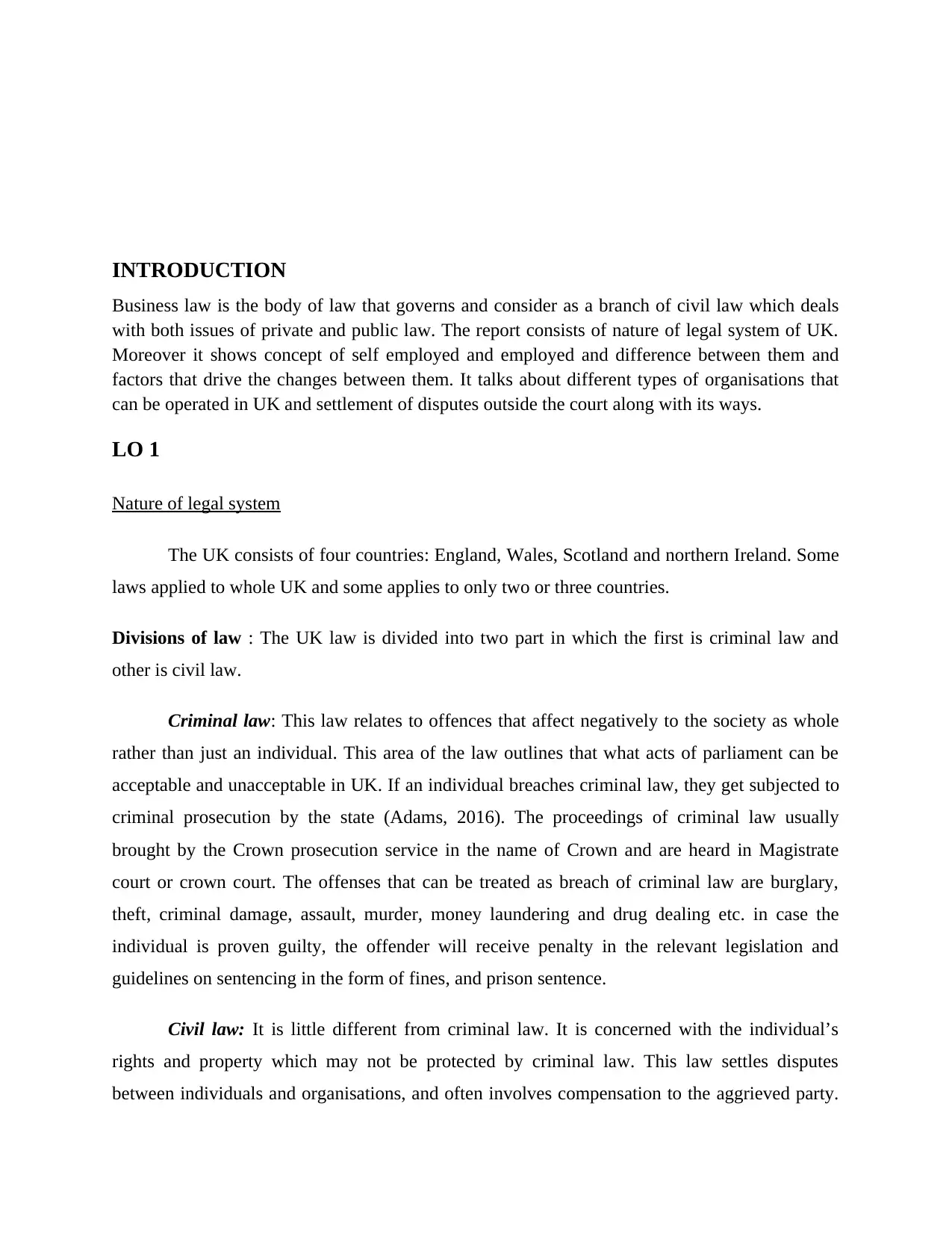
INTRODUCTION
Business law is the body of law that governs and consider as a branch of civil law which deals
with both issues of private and public law. The report consists of nature of legal system of UK.
Moreover it shows concept of self employed and employed and difference between them and
factors that drive the changes between them. It talks about different types of organisations that
can be operated in UK and settlement of disputes outside the court along with its ways.
LO 1
Nature of legal system
The UK consists of four countries: England, Wales, Scotland and northern Ireland. Some
laws applied to whole UK and some applies to only two or three countries.
Divisions of law : The UK law is divided into two part in which the first is criminal law and
other is civil law.
Criminal law: This law relates to offences that affect negatively to the society as whole
rather than just an individual. This area of the law outlines that what acts of parliament can be
acceptable and unacceptable in UK. If an individual breaches criminal law, they get subjected to
criminal prosecution by the state (Adams, 2016). The proceedings of criminal law usually
brought by the Crown prosecution service in the name of Crown and are heard in Magistrate
court or crown court. The offenses that can be treated as breach of criminal law are burglary,
theft, criminal damage, assault, murder, money laundering and drug dealing etc. in case the
individual is proven guilty, the offender will receive penalty in the relevant legislation and
guidelines on sentencing in the form of fines, and prison sentence.
Civil law: It is little different from criminal law. It is concerned with the individual’s
rights and property which may not be protected by criminal law. This law settles disputes
between individuals and organisations, and often involves compensation to the aggrieved party.
Business law is the body of law that governs and consider as a branch of civil law which deals
with both issues of private and public law. The report consists of nature of legal system of UK.
Moreover it shows concept of self employed and employed and difference between them and
factors that drive the changes between them. It talks about different types of organisations that
can be operated in UK and settlement of disputes outside the court along with its ways.
LO 1
Nature of legal system
The UK consists of four countries: England, Wales, Scotland and northern Ireland. Some
laws applied to whole UK and some applies to only two or three countries.
Divisions of law : The UK law is divided into two part in which the first is criminal law and
other is civil law.
Criminal law: This law relates to offences that affect negatively to the society as whole
rather than just an individual. This area of the law outlines that what acts of parliament can be
acceptable and unacceptable in UK. If an individual breaches criminal law, they get subjected to
criminal prosecution by the state (Adams, 2016). The proceedings of criminal law usually
brought by the Crown prosecution service in the name of Crown and are heard in Magistrate
court or crown court. The offenses that can be treated as breach of criminal law are burglary,
theft, criminal damage, assault, murder, money laundering and drug dealing etc. in case the
individual is proven guilty, the offender will receive penalty in the relevant legislation and
guidelines on sentencing in the form of fines, and prison sentence.
Civil law: It is little different from criminal law. It is concerned with the individual’s
rights and property which may not be protected by criminal law. This law settles disputes
between individuals and organisations, and often involves compensation to the aggrieved party.
⊘ This is a preview!⊘
Do you want full access?
Subscribe today to unlock all pages.

Trusted by 1+ million students worldwide
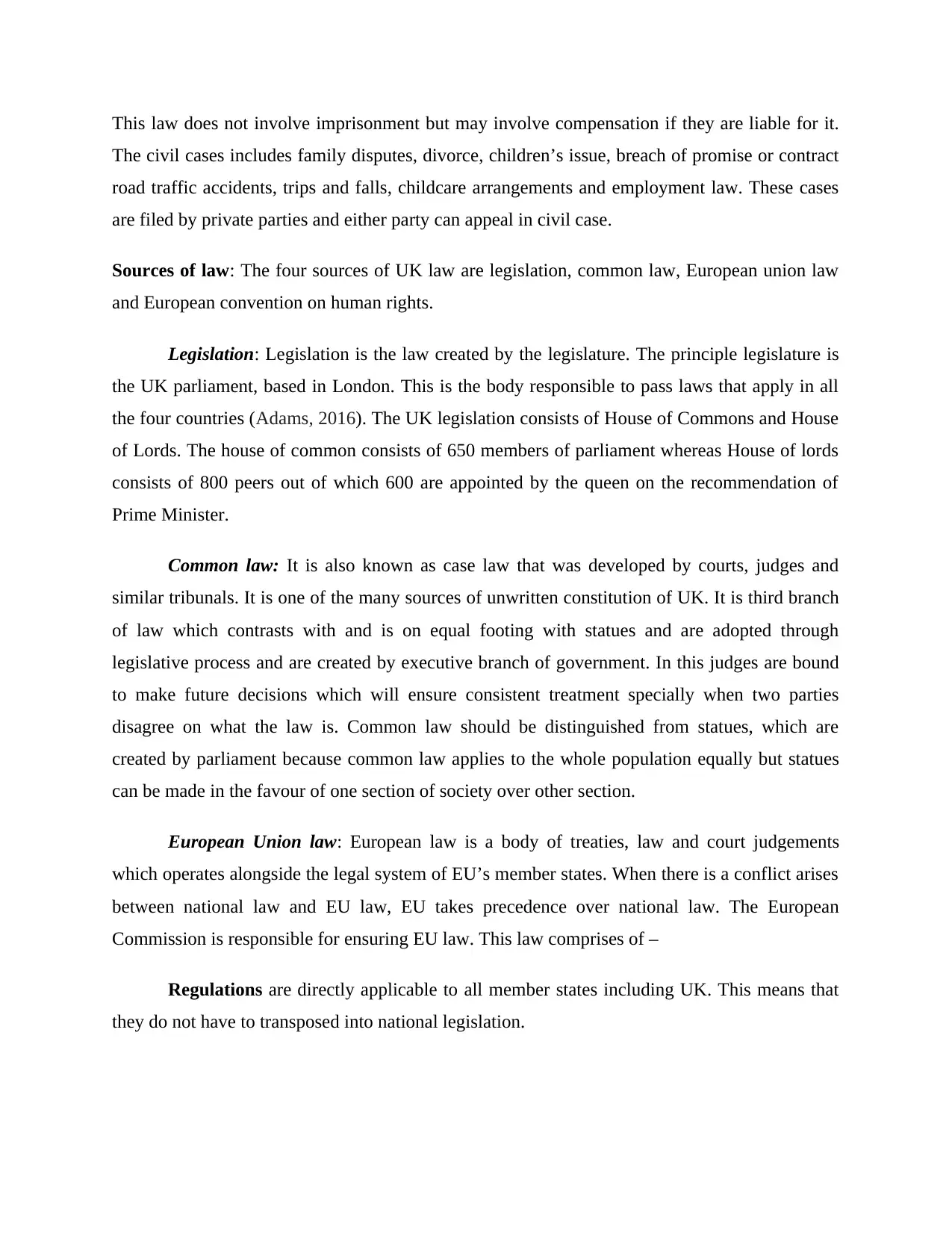
This law does not involve imprisonment but may involve compensation if they are liable for it.
The civil cases includes family disputes, divorce, children’s issue, breach of promise or contract
road traffic accidents, trips and falls, childcare arrangements and employment law. These cases
are filed by private parties and either party can appeal in civil case.
Sources of law: The four sources of UK law are legislation, common law, European union law
and European convention on human rights.
Legislation: Legislation is the law created by the legislature. The principle legislature is
the UK parliament, based in London. This is the body responsible to pass laws that apply in all
the four countries (Adams, 2016). The UK legislation consists of House of Commons and House
of Lords. The house of common consists of 650 members of parliament whereas House of lords
consists of 800 peers out of which 600 are appointed by the queen on the recommendation of
Prime Minister.
Common law: It is also known as case law that was developed by courts, judges and
similar tribunals. It is one of the many sources of unwritten constitution of UK. It is third branch
of law which contrasts with and is on equal footing with statues and are adopted through
legislative process and are created by executive branch of government. In this judges are bound
to make future decisions which will ensure consistent treatment specially when two parties
disagree on what the law is. Common law should be distinguished from statues, which are
created by parliament because common law applies to the whole population equally but statues
can be made in the favour of one section of society over other section.
European Union law: European law is a body of treaties, law and court judgements
which operates alongside the legal system of EU’s member states. When there is a conflict arises
between national law and EU law, EU takes precedence over national law. The European
Commission is responsible for ensuring EU law. This law comprises of –
Regulations are directly applicable to all member states including UK. This means that
they do not have to transposed into national legislation.
The civil cases includes family disputes, divorce, children’s issue, breach of promise or contract
road traffic accidents, trips and falls, childcare arrangements and employment law. These cases
are filed by private parties and either party can appeal in civil case.
Sources of law: The four sources of UK law are legislation, common law, European union law
and European convention on human rights.
Legislation: Legislation is the law created by the legislature. The principle legislature is
the UK parliament, based in London. This is the body responsible to pass laws that apply in all
the four countries (Adams, 2016). The UK legislation consists of House of Commons and House
of Lords. The house of common consists of 650 members of parliament whereas House of lords
consists of 800 peers out of which 600 are appointed by the queen on the recommendation of
Prime Minister.
Common law: It is also known as case law that was developed by courts, judges and
similar tribunals. It is one of the many sources of unwritten constitution of UK. It is third branch
of law which contrasts with and is on equal footing with statues and are adopted through
legislative process and are created by executive branch of government. In this judges are bound
to make future decisions which will ensure consistent treatment specially when two parties
disagree on what the law is. Common law should be distinguished from statues, which are
created by parliament because common law applies to the whole population equally but statues
can be made in the favour of one section of society over other section.
European Union law: European law is a body of treaties, law and court judgements
which operates alongside the legal system of EU’s member states. When there is a conflict arises
between national law and EU law, EU takes precedence over national law. The European
Commission is responsible for ensuring EU law. This law comprises of –
Regulations are directly applicable to all member states including UK. This means that
they do not have to transposed into national legislation.
Paraphrase This Document
Need a fresh take? Get an instant paraphrase of this document with our AI Paraphraser
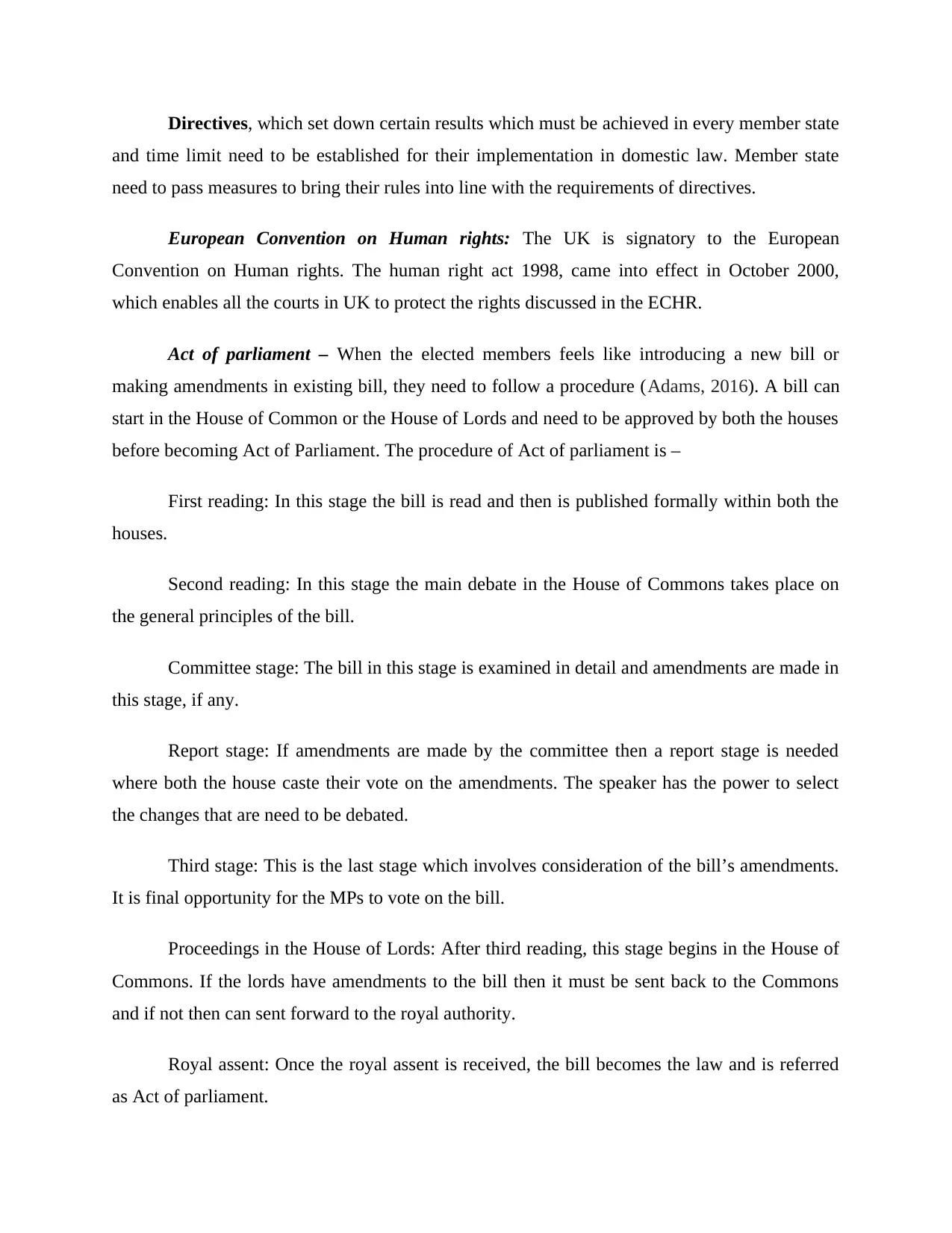
Directives, which set down certain results which must be achieved in every member state
and time limit need to be established for their implementation in domestic law. Member state
need to pass measures to bring their rules into line with the requirements of directives.
European Convention on Human rights: The UK is signatory to the European
Convention on Human rights. The human right act 1998, came into effect in October 2000,
which enables all the courts in UK to protect the rights discussed in the ECHR.
Act of parliament – When the elected members feels like introducing a new bill or
making amendments in existing bill, they need to follow a procedure (Adams, 2016). A bill can
start in the House of Common or the House of Lords and need to be approved by both the houses
before becoming Act of Parliament. The procedure of Act of parliament is –
First reading: In this stage the bill is read and then is published formally within both the
houses.
Second reading: In this stage the main debate in the House of Commons takes place on
the general principles of the bill.
Committee stage: The bill in this stage is examined in detail and amendments are made in
this stage, if any.
Report stage: If amendments are made by the committee then a report stage is needed
where both the house caste their vote on the amendments. The speaker has the power to select
the changes that are need to be debated.
Third stage: This is the last stage which involves consideration of the bill’s amendments.
It is final opportunity for the MPs to vote on the bill.
Proceedings in the House of Lords: After third reading, this stage begins in the House of
Commons. If the lords have amendments to the bill then it must be sent back to the Commons
and if not then can sent forward to the royal authority.
Royal assent: Once the royal assent is received, the bill becomes the law and is referred
as Act of parliament.
and time limit need to be established for their implementation in domestic law. Member state
need to pass measures to bring their rules into line with the requirements of directives.
European Convention on Human rights: The UK is signatory to the European
Convention on Human rights. The human right act 1998, came into effect in October 2000,
which enables all the courts in UK to protect the rights discussed in the ECHR.
Act of parliament – When the elected members feels like introducing a new bill or
making amendments in existing bill, they need to follow a procedure (Adams, 2016). A bill can
start in the House of Common or the House of Lords and need to be approved by both the houses
before becoming Act of Parliament. The procedure of Act of parliament is –
First reading: In this stage the bill is read and then is published formally within both the
houses.
Second reading: In this stage the main debate in the House of Commons takes place on
the general principles of the bill.
Committee stage: The bill in this stage is examined in detail and amendments are made in
this stage, if any.
Report stage: If amendments are made by the committee then a report stage is needed
where both the house caste their vote on the amendments. The speaker has the power to select
the changes that are need to be debated.
Third stage: This is the last stage which involves consideration of the bill’s amendments.
It is final opportunity for the MPs to vote on the bill.
Proceedings in the House of Lords: After third reading, this stage begins in the House of
Commons. If the lords have amendments to the bill then it must be sent back to the Commons
and if not then can sent forward to the royal authority.
Royal assent: Once the royal assent is received, the bill becomes the law and is referred
as Act of parliament.
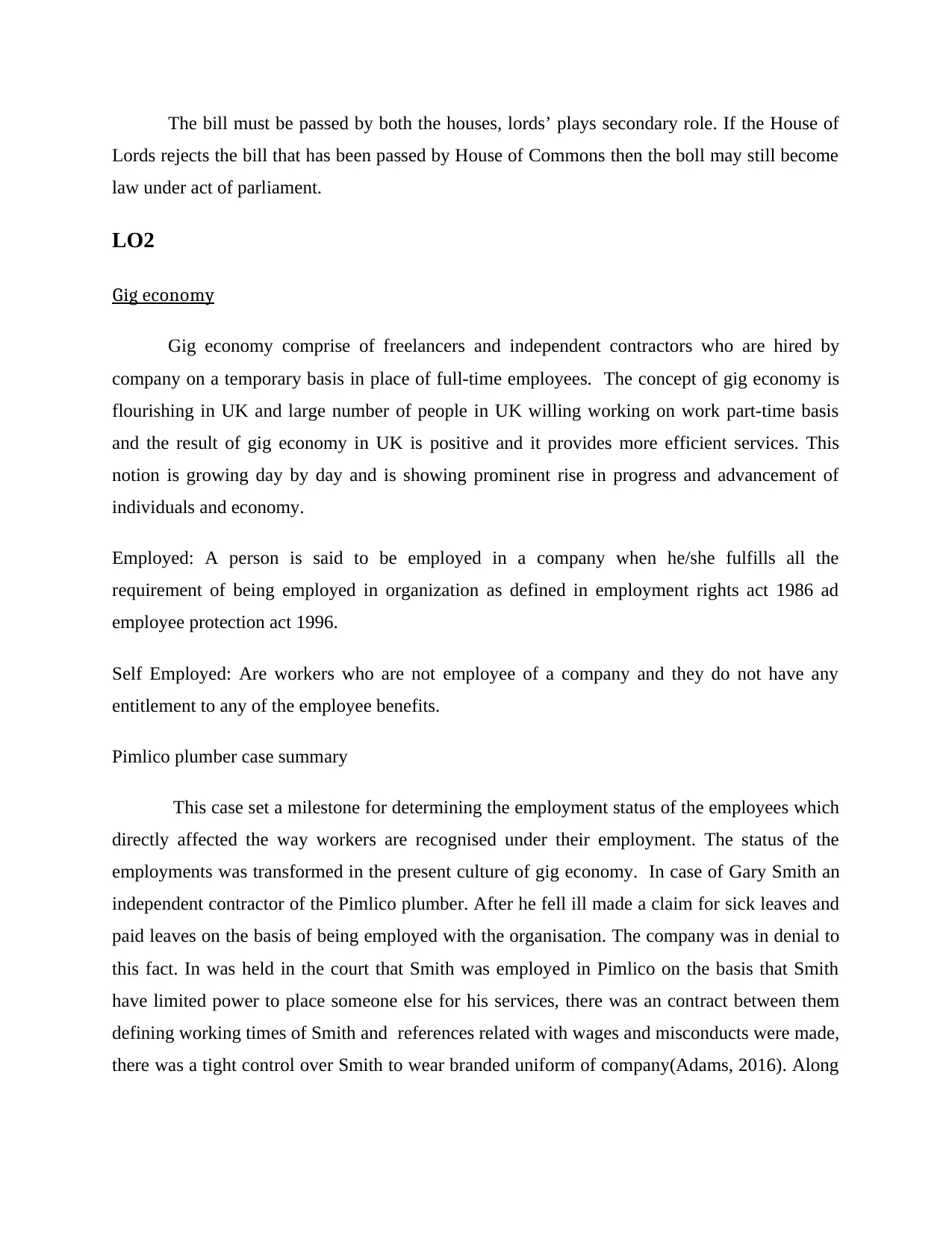
The bill must be passed by both the houses, lords’ plays secondary role. If the House of
Lords rejects the bill that has been passed by House of Commons then the boll may still become
law under act of parliament.
LO2
Gig economy
Gig economy comprise of freelancers and independent contractors who are hired by
company on a temporary basis in place of full-time employees. The concept of gig economy is
flourishing in UK and large number of people in UK willing working on work part-time basis
and the result of gig economy in UK is positive and it provides more efficient services. This
notion is growing day by day and is showing prominent rise in progress and advancement of
individuals and economy.
Employed: A person is said to be employed in a company when he/she fulfills all the
requirement of being employed in organization as defined in employment rights act 1986 ad
employee protection act 1996.
Self Employed: Are workers who are not employee of a company and they do not have any
entitlement to any of the employee benefits.
Pimlico plumber case summary
This case set a milestone for determining the employment status of the employees which
directly affected the way workers are recognised under their employment. The status of the
employments was transformed in the present culture of gig economy. In case of Gary Smith an
independent contractor of the Pimlico plumber. After he fell ill made a claim for sick leaves and
paid leaves on the basis of being employed with the organisation. The company was in denial to
this fact. In was held in the court that Smith was employed in Pimlico on the basis that Smith
have limited power to place someone else for his services, there was an contract between them
defining working times of Smith and references related with wages and misconducts were made,
there was a tight control over Smith to wear branded uniform of company(Adams, 2016). Along
Lords rejects the bill that has been passed by House of Commons then the boll may still become
law under act of parliament.
LO2
Gig economy
Gig economy comprise of freelancers and independent contractors who are hired by
company on a temporary basis in place of full-time employees. The concept of gig economy is
flourishing in UK and large number of people in UK willing working on work part-time basis
and the result of gig economy in UK is positive and it provides more efficient services. This
notion is growing day by day and is showing prominent rise in progress and advancement of
individuals and economy.
Employed: A person is said to be employed in a company when he/she fulfills all the
requirement of being employed in organization as defined in employment rights act 1986 ad
employee protection act 1996.
Self Employed: Are workers who are not employee of a company and they do not have any
entitlement to any of the employee benefits.
Pimlico plumber case summary
This case set a milestone for determining the employment status of the employees which
directly affected the way workers are recognised under their employment. The status of the
employments was transformed in the present culture of gig economy. In case of Gary Smith an
independent contractor of the Pimlico plumber. After he fell ill made a claim for sick leaves and
paid leaves on the basis of being employed with the organisation. The company was in denial to
this fact. In was held in the court that Smith was employed in Pimlico on the basis that Smith
have limited power to place someone else for his services, there was an contract between them
defining working times of Smith and references related with wages and misconducts were made,
there was a tight control over Smith to wear branded uniform of company(Adams, 2016). Along
⊘ This is a preview!⊘
Do you want full access?
Subscribe today to unlock all pages.

Trusted by 1+ million students worldwide
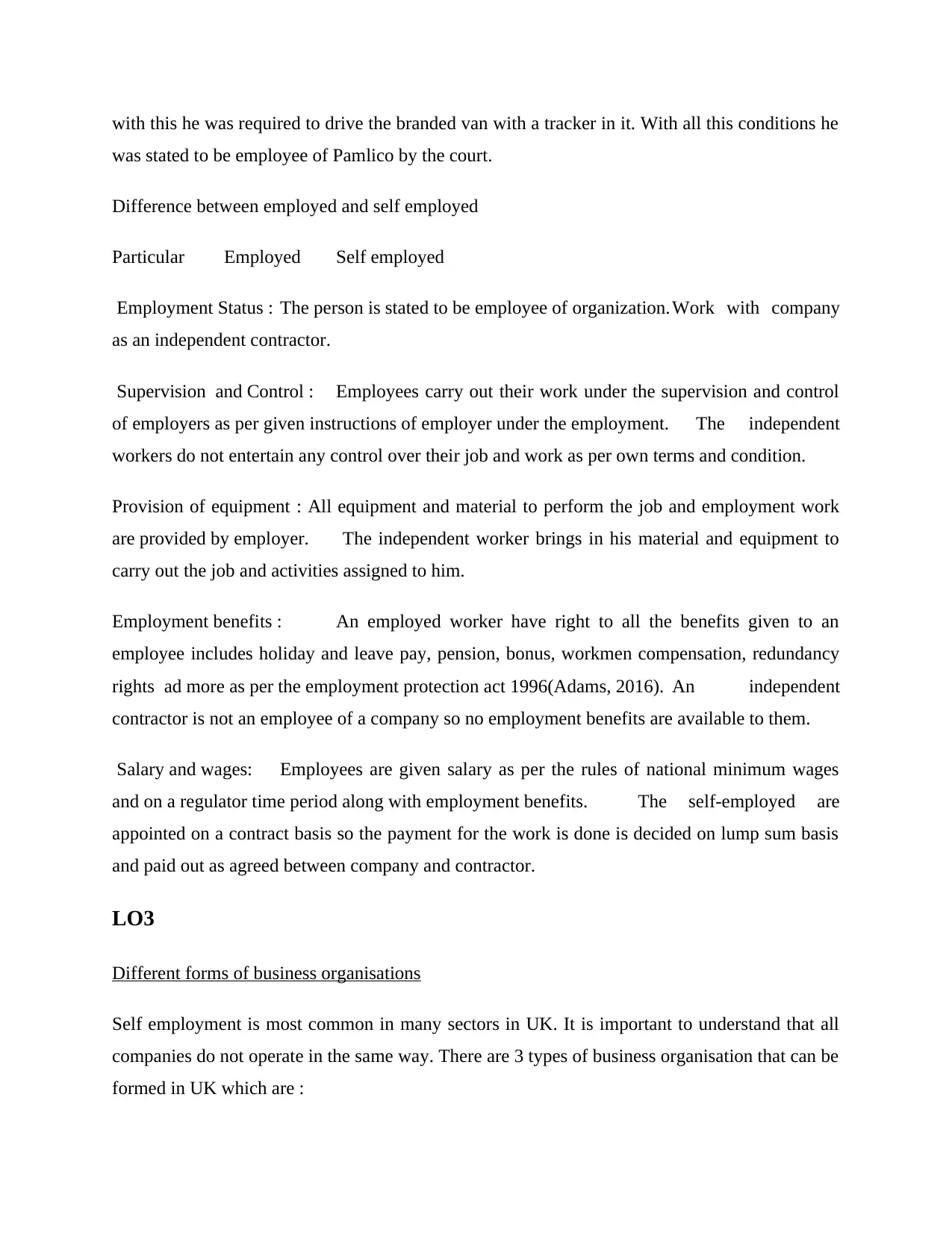
with this he was required to drive the branded van with a tracker in it. With all this conditions he
was stated to be employee of Pamlico by the court.
Difference between employed and self employed
Particular Employed Self employed
Employment Status : The person is stated to be employee of organization.Work with company
as an independent contractor.
Supervision and Control : Employees carry out their work under the supervision and control
of employers as per given instructions of employer under the employment. The independent
workers do not entertain any control over their job and work as per own terms and condition.
Provision of equipment : All equipment and material to perform the job and employment work
are provided by employer. The independent worker brings in his material and equipment to
carry out the job and activities assigned to him.
Employment benefits : An employed worker have right to all the benefits given to an
employee includes holiday and leave pay, pension, bonus, workmen compensation, redundancy
rights ad more as per the employment protection act 1996(Adams, 2016). An independent
contractor is not an employee of a company so no employment benefits are available to them.
Salary and wages: Employees are given salary as per the rules of national minimum wages
and on a regulator time period along with employment benefits. The self-employed are
appointed on a contract basis so the payment for the work is done is decided on lump sum basis
and paid out as agreed between company and contractor.
LO3
Different forms of business organisations
Self employment is most common in many sectors in UK. It is important to understand that all
companies do not operate in the same way. There are 3 types of business organisation that can be
formed in UK which are :
was stated to be employee of Pamlico by the court.
Difference between employed and self employed
Particular Employed Self employed
Employment Status : The person is stated to be employee of organization.Work with company
as an independent contractor.
Supervision and Control : Employees carry out their work under the supervision and control
of employers as per given instructions of employer under the employment. The independent
workers do not entertain any control over their job and work as per own terms and condition.
Provision of equipment : All equipment and material to perform the job and employment work
are provided by employer. The independent worker brings in his material and equipment to
carry out the job and activities assigned to him.
Employment benefits : An employed worker have right to all the benefits given to an
employee includes holiday and leave pay, pension, bonus, workmen compensation, redundancy
rights ad more as per the employment protection act 1996(Adams, 2016). An independent
contractor is not an employee of a company so no employment benefits are available to them.
Salary and wages: Employees are given salary as per the rules of national minimum wages
and on a regulator time period along with employment benefits. The self-employed are
appointed on a contract basis so the payment for the work is done is decided on lump sum basis
and paid out as agreed between company and contractor.
LO3
Different forms of business organisations
Self employment is most common in many sectors in UK. It is important to understand that all
companies do not operate in the same way. There are 3 types of business organisation that can be
formed in UK which are :
Paraphrase This Document
Need a fresh take? Get an instant paraphrase of this document with our AI Paraphraser
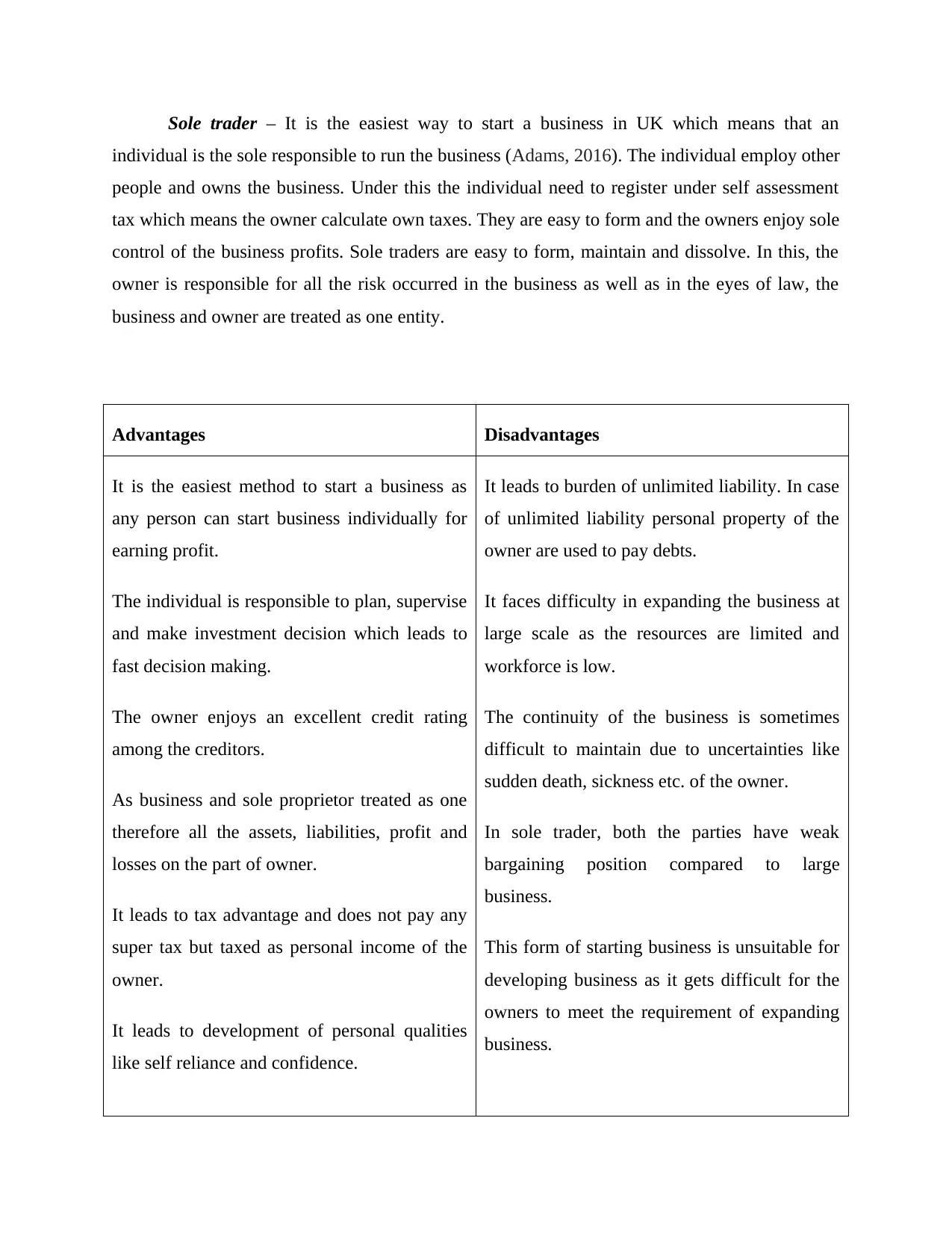
Sole trader – It is the easiest way to start a business in UK which means that an
individual is the sole responsible to run the business (Adams, 2016). The individual employ other
people and owns the business. Under this the individual need to register under self assessment
tax which means the owner calculate own taxes. They are easy to form and the owners enjoy sole
control of the business profits. Sole traders are easy to form, maintain and dissolve. In this, the
owner is responsible for all the risk occurred in the business as well as in the eyes of law, the
business and owner are treated as one entity.
Advantages Disadvantages
It is the easiest method to start a business as
any person can start business individually for
earning profit.
The individual is responsible to plan, supervise
and make investment decision which leads to
fast decision making.
The owner enjoys an excellent credit rating
among the creditors.
As business and sole proprietor treated as one
therefore all the assets, liabilities, profit and
losses on the part of owner.
It leads to tax advantage and does not pay any
super tax but taxed as personal income of the
owner.
It leads to development of personal qualities
like self reliance and confidence.
It leads to burden of unlimited liability. In case
of unlimited liability personal property of the
owner are used to pay debts.
It faces difficulty in expanding the business at
large scale as the resources are limited and
workforce is low.
The continuity of the business is sometimes
difficult to maintain due to uncertainties like
sudden death, sickness etc. of the owner.
In sole trader, both the parties have weak
bargaining position compared to large
business.
This form of starting business is unsuitable for
developing business as it gets difficult for the
owners to meet the requirement of expanding
business.
individual is the sole responsible to run the business (Adams, 2016). The individual employ other
people and owns the business. Under this the individual need to register under self assessment
tax which means the owner calculate own taxes. They are easy to form and the owners enjoy sole
control of the business profits. Sole traders are easy to form, maintain and dissolve. In this, the
owner is responsible for all the risk occurred in the business as well as in the eyes of law, the
business and owner are treated as one entity.
Advantages Disadvantages
It is the easiest method to start a business as
any person can start business individually for
earning profit.
The individual is responsible to plan, supervise
and make investment decision which leads to
fast decision making.
The owner enjoys an excellent credit rating
among the creditors.
As business and sole proprietor treated as one
therefore all the assets, liabilities, profit and
losses on the part of owner.
It leads to tax advantage and does not pay any
super tax but taxed as personal income of the
owner.
It leads to development of personal qualities
like self reliance and confidence.
It leads to burden of unlimited liability. In case
of unlimited liability personal property of the
owner are used to pay debts.
It faces difficulty in expanding the business at
large scale as the resources are limited and
workforce is low.
The continuity of the business is sometimes
difficult to maintain due to uncertainties like
sudden death, sickness etc. of the owner.
In sole trader, both the parties have weak
bargaining position compared to large
business.
This form of starting business is unsuitable for
developing business as it gets difficult for the
owners to meet the requirement of expanding
business.
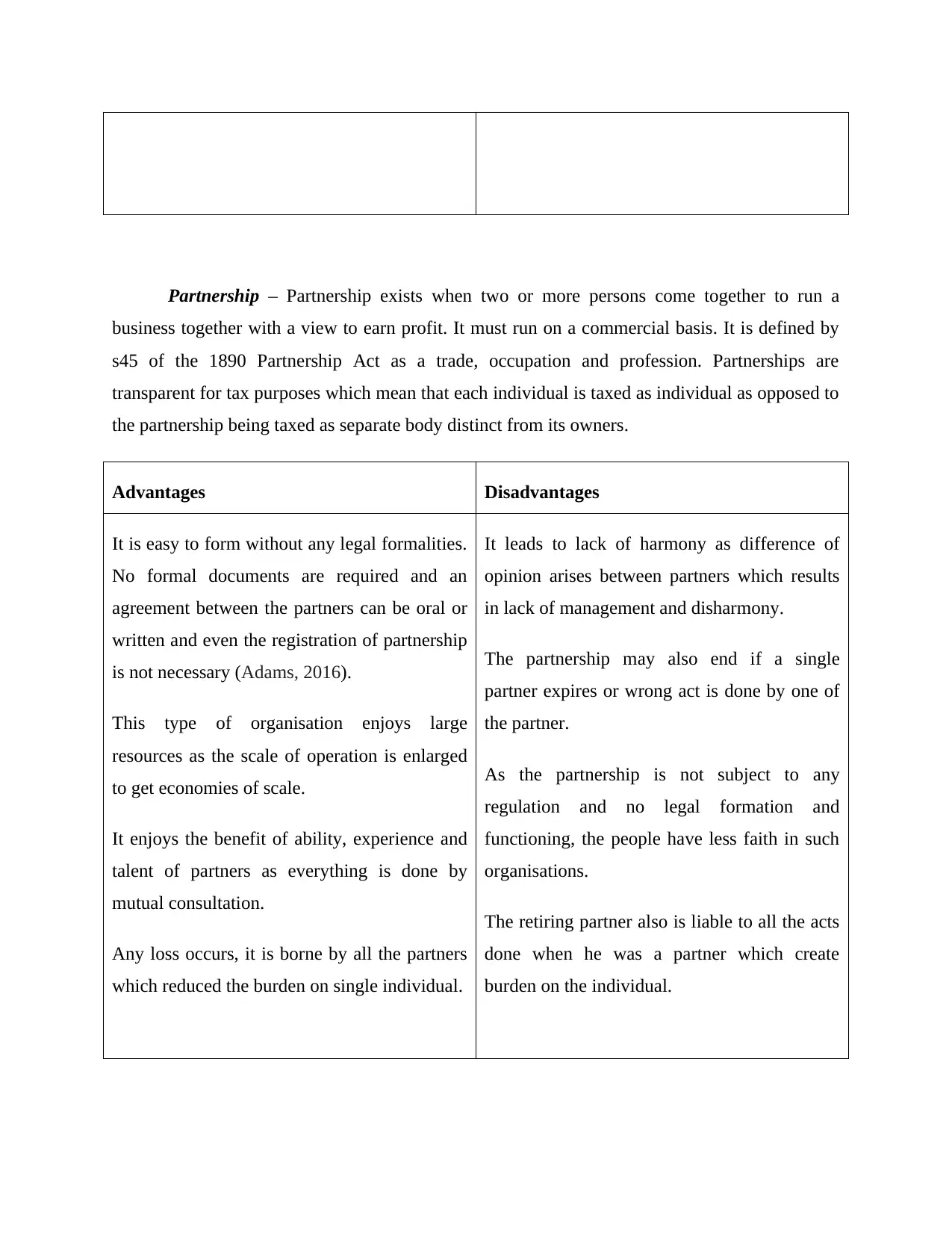
Partnership – Partnership exists when two or more persons come together to run a
business together with a view to earn profit. It must run on a commercial basis. It is defined by
s45 of the 1890 Partnership Act as a trade, occupation and profession. Partnerships are
transparent for tax purposes which mean that each individual is taxed as individual as opposed to
the partnership being taxed as separate body distinct from its owners.
Advantages Disadvantages
It is easy to form without any legal formalities.
No formal documents are required and an
agreement between the partners can be oral or
written and even the registration of partnership
is not necessary (Adams, 2016).
This type of organisation enjoys large
resources as the scale of operation is enlarged
to get economies of scale.
It enjoys the benefit of ability, experience and
talent of partners as everything is done by
mutual consultation.
Any loss occurs, it is borne by all the partners
which reduced the burden on single individual.
It leads to lack of harmony as difference of
opinion arises between partners which results
in lack of management and disharmony.
The partnership may also end if a single
partner expires or wrong act is done by one of
the partner.
As the partnership is not subject to any
regulation and no legal formation and
functioning, the people have less faith in such
organisations.
The retiring partner also is liable to all the acts
done when he was a partner which create
burden on the individual.
business together with a view to earn profit. It must run on a commercial basis. It is defined by
s45 of the 1890 Partnership Act as a trade, occupation and profession. Partnerships are
transparent for tax purposes which mean that each individual is taxed as individual as opposed to
the partnership being taxed as separate body distinct from its owners.
Advantages Disadvantages
It is easy to form without any legal formalities.
No formal documents are required and an
agreement between the partners can be oral or
written and even the registration of partnership
is not necessary (Adams, 2016).
This type of organisation enjoys large
resources as the scale of operation is enlarged
to get economies of scale.
It enjoys the benefit of ability, experience and
talent of partners as everything is done by
mutual consultation.
Any loss occurs, it is borne by all the partners
which reduced the burden on single individual.
It leads to lack of harmony as difference of
opinion arises between partners which results
in lack of management and disharmony.
The partnership may also end if a single
partner expires or wrong act is done by one of
the partner.
As the partnership is not subject to any
regulation and no legal formation and
functioning, the people have less faith in such
organisations.
The retiring partner also is liable to all the acts
done when he was a partner which create
burden on the individual.
⊘ This is a preview!⊘
Do you want full access?
Subscribe today to unlock all pages.

Trusted by 1+ million students worldwide
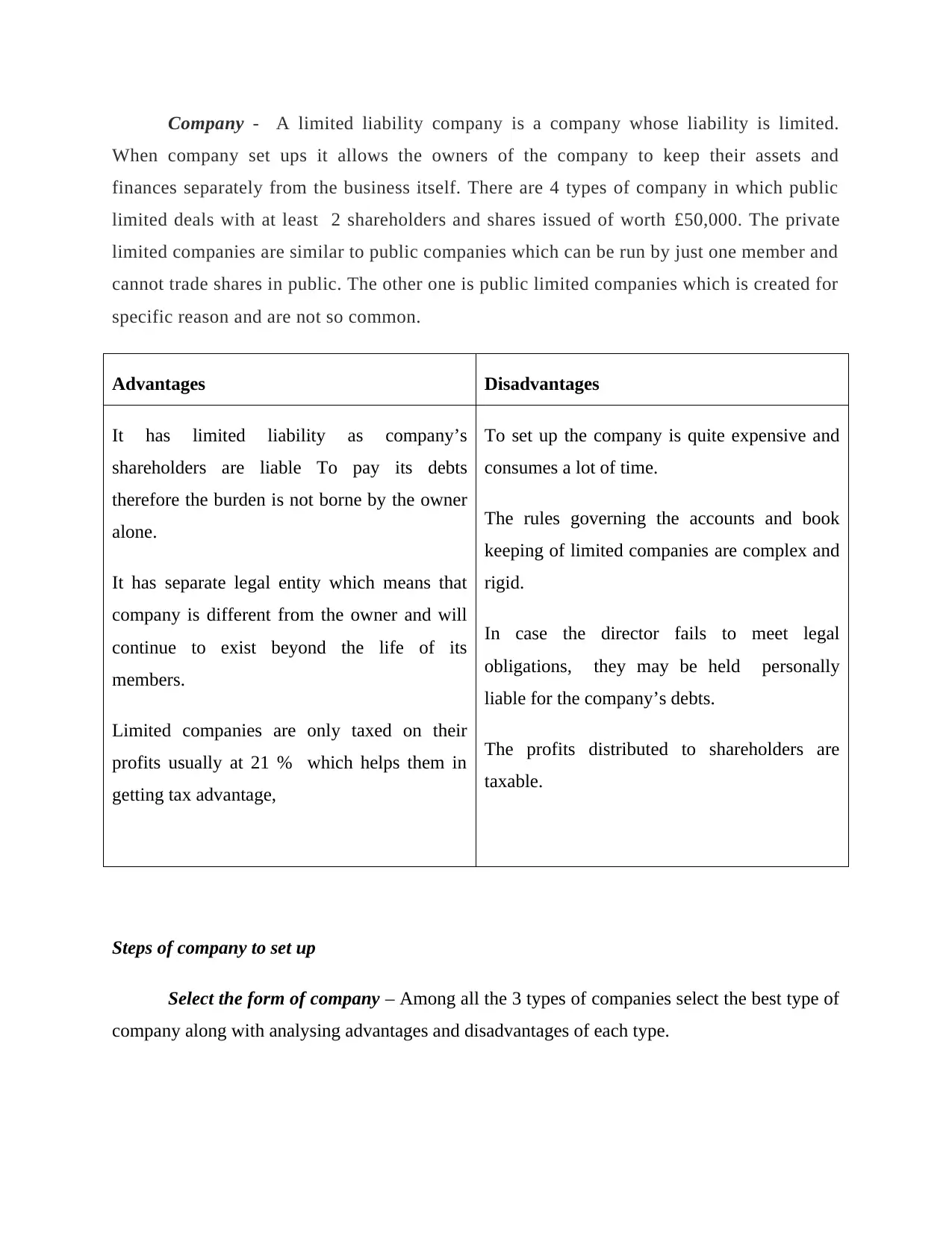
Company - A limited liability company is a company whose liability is limited.
When company set ups it allows the owners of the company to keep their assets and
finances separately from the business itself. There are 4 types of company in which public
limited deals with at least 2 shareholders and shares issued of worth £50,000. The private
limited companies are similar to public companies which can be run by just one member and
cannot trade shares in public. The other one is public limited companies which is created for
specific reason and are not so common.
Advantages Disadvantages
It has limited liability as company’s
shareholders are liable To pay its debts
therefore the burden is not borne by the owner
alone.
It has separate legal entity which means that
company is different from the owner and will
continue to exist beyond the life of its
members.
Limited companies are only taxed on their
profits usually at 21 % which helps them in
getting tax advantage,
To set up the company is quite expensive and
consumes a lot of time.
The rules governing the accounts and book
keeping of limited companies are complex and
rigid.
In case the director fails to meet legal
obligations, they may be held personally
liable for the company’s debts.
The profits distributed to shareholders are
taxable.
Steps of company to set up
Select the form of company – Among all the 3 types of companies select the best type of
company along with analysing advantages and disadvantages of each type.
When company set ups it allows the owners of the company to keep their assets and
finances separately from the business itself. There are 4 types of company in which public
limited deals with at least 2 shareholders and shares issued of worth £50,000. The private
limited companies are similar to public companies which can be run by just one member and
cannot trade shares in public. The other one is public limited companies which is created for
specific reason and are not so common.
Advantages Disadvantages
It has limited liability as company’s
shareholders are liable To pay its debts
therefore the burden is not borne by the owner
alone.
It has separate legal entity which means that
company is different from the owner and will
continue to exist beyond the life of its
members.
Limited companies are only taxed on their
profits usually at 21 % which helps them in
getting tax advantage,
To set up the company is quite expensive and
consumes a lot of time.
The rules governing the accounts and book
keeping of limited companies are complex and
rigid.
In case the director fails to meet legal
obligations, they may be held personally
liable for the company’s debts.
The profits distributed to shareholders are
taxable.
Steps of company to set up
Select the form of company – Among all the 3 types of companies select the best type of
company along with analysing advantages and disadvantages of each type.
Paraphrase This Document
Need a fresh take? Get an instant paraphrase of this document with our AI Paraphraser
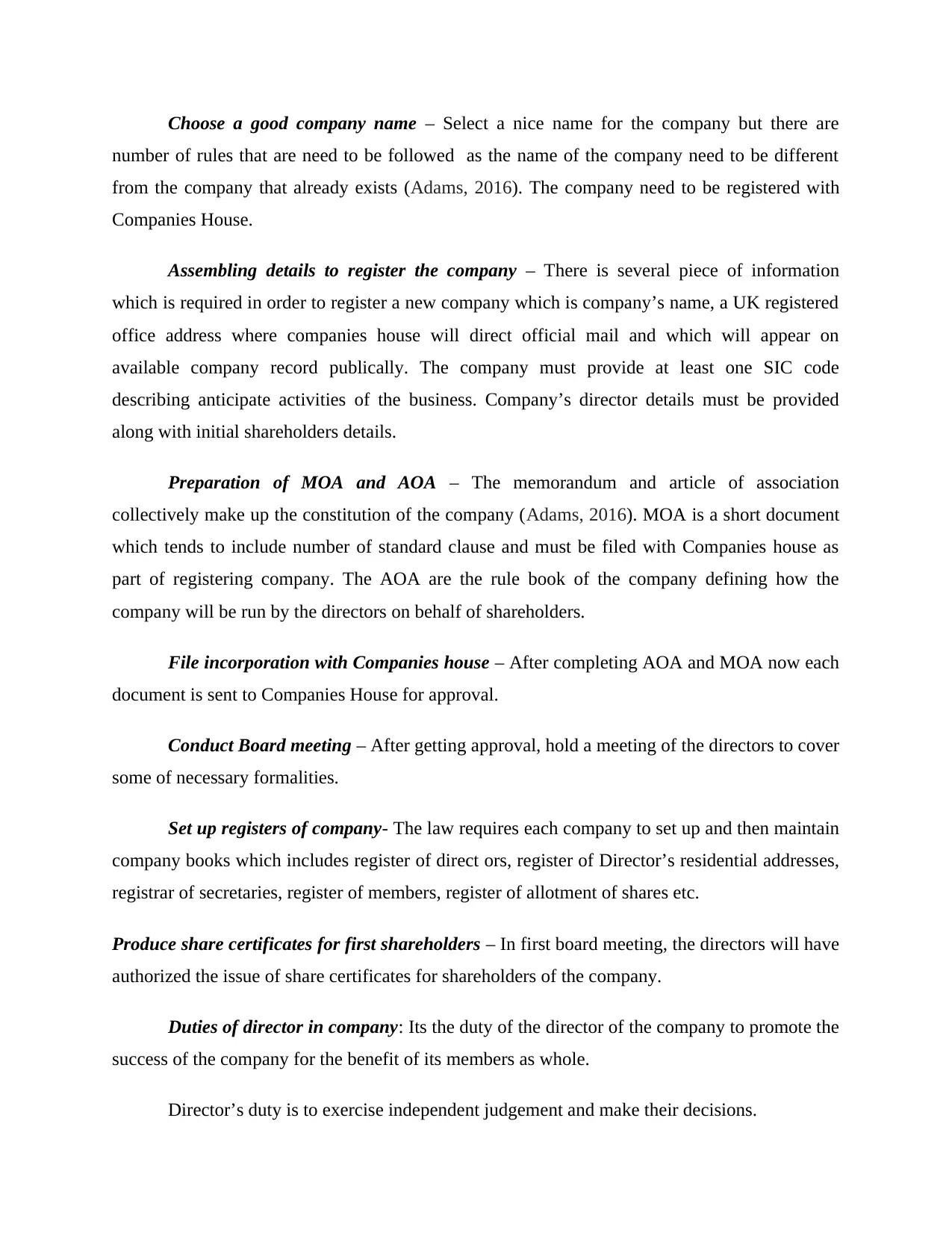
Choose a good company name – Select a nice name for the company but there are
number of rules that are need to be followed as the name of the company need to be different
from the company that already exists (Adams, 2016). The company need to be registered with
Companies House.
Assembling details to register the company – There is several piece of information
which is required in order to register a new company which is company’s name, a UK registered
office address where companies house will direct official mail and which will appear on
available company record publically. The company must provide at least one SIC code
describing anticipate activities of the business. Company’s director details must be provided
along with initial shareholders details.
Preparation of MOA and AOA – The memorandum and article of association
collectively make up the constitution of the company (Adams, 2016). MOA is a short document
which tends to include number of standard clause and must be filed with Companies house as
part of registering company. The AOA are the rule book of the company defining how the
company will be run by the directors on behalf of shareholders.
File incorporation with Companies house – After completing AOA and MOA now each
document is sent to Companies House for approval.
Conduct Board meeting – After getting approval, hold a meeting of the directors to cover
some of necessary formalities.
Set up registers of company- The law requires each company to set up and then maintain
company books which includes register of direct ors, register of Director’s residential addresses,
registrar of secretaries, register of members, register of allotment of shares etc.
Produce share certificates for first shareholders – In first board meeting, the directors will have
authorized the issue of share certificates for shareholders of the company.
Duties of director in company: Its the duty of the director of the company to promote the
success of the company for the benefit of its members as whole.
Director’s duty is to exercise independent judgement and make their decisions.
number of rules that are need to be followed as the name of the company need to be different
from the company that already exists (Adams, 2016). The company need to be registered with
Companies House.
Assembling details to register the company – There is several piece of information
which is required in order to register a new company which is company’s name, a UK registered
office address where companies house will direct official mail and which will appear on
available company record publically. The company must provide at least one SIC code
describing anticipate activities of the business. Company’s director details must be provided
along with initial shareholders details.
Preparation of MOA and AOA – The memorandum and article of association
collectively make up the constitution of the company (Adams, 2016). MOA is a short document
which tends to include number of standard clause and must be filed with Companies house as
part of registering company. The AOA are the rule book of the company defining how the
company will be run by the directors on behalf of shareholders.
File incorporation with Companies house – After completing AOA and MOA now each
document is sent to Companies House for approval.
Conduct Board meeting – After getting approval, hold a meeting of the directors to cover
some of necessary formalities.
Set up registers of company- The law requires each company to set up and then maintain
company books which includes register of direct ors, register of Director’s residential addresses,
registrar of secretaries, register of members, register of allotment of shares etc.
Produce share certificates for first shareholders – In first board meeting, the directors will have
authorized the issue of share certificates for shareholders of the company.
Duties of director in company: Its the duty of the director of the company to promote the
success of the company for the benefit of its members as whole.
Director’s duty is to exercise independent judgement and make their decisions.
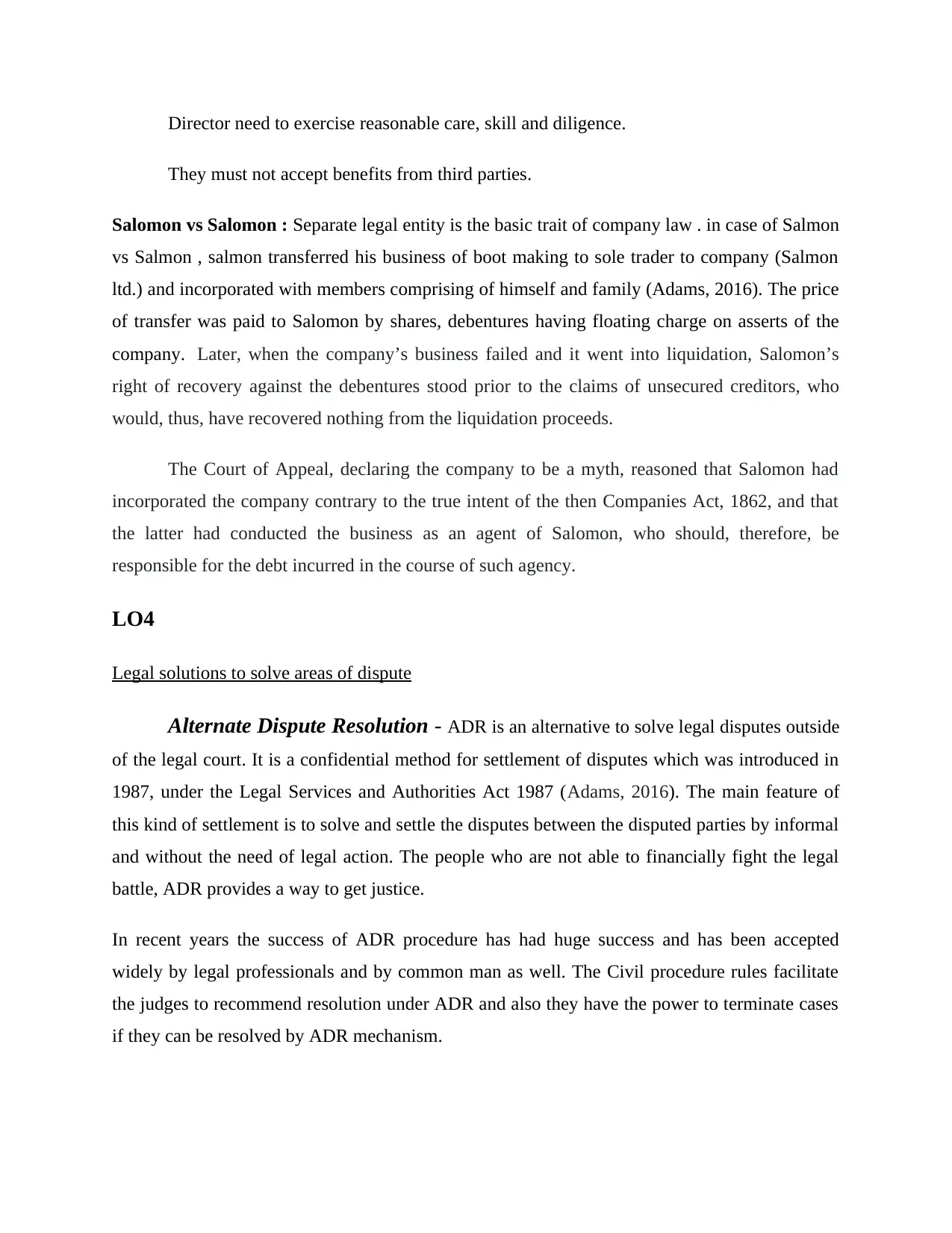
Director need to exercise reasonable care, skill and diligence.
They must not accept benefits from third parties.
Salomon vs Salomon : Separate legal entity is the basic trait of company law . in case of Salmon
vs Salmon , salmon transferred his business of boot making to sole trader to company (Salmon
ltd.) and incorporated with members comprising of himself and family (Adams, 2016). The price
of transfer was paid to Salomon by shares, debentures having floating charge on asserts of the
company. Later, when the company’s business failed and it went into liquidation, Salomon’s
right of recovery against the debentures stood prior to the claims of unsecured creditors, who
would, thus, have recovered nothing from the liquidation proceeds.
The Court of Appeal, declaring the company to be a myth, reasoned that Salomon had
incorporated the company contrary to the true intent of the then Companies Act, 1862, and that
the latter had conducted the business as an agent of Salomon, who should, therefore, be
responsible for the debt incurred in the course of such agency.
LO4
Legal solutions to solve areas of dispute
Alternate Dispute Resolution - ADR is an alternative to solve legal disputes outside
of the legal court. It is a confidential method for settlement of disputes which was introduced in
1987, under the Legal Services and Authorities Act 1987 (Adams, 2016). The main feature of
this kind of settlement is to solve and settle the disputes between the disputed parties by informal
and without the need of legal action. The people who are not able to financially fight the legal
battle, ADR provides a way to get justice.
In recent years the success of ADR procedure has had huge success and has been accepted
widely by legal professionals and by common man as well. The Civil procedure rules facilitate
the judges to recommend resolution under ADR and also they have the power to terminate cases
if they can be resolved by ADR mechanism.
They must not accept benefits from third parties.
Salomon vs Salomon : Separate legal entity is the basic trait of company law . in case of Salmon
vs Salmon , salmon transferred his business of boot making to sole trader to company (Salmon
ltd.) and incorporated with members comprising of himself and family (Adams, 2016). The price
of transfer was paid to Salomon by shares, debentures having floating charge on asserts of the
company. Later, when the company’s business failed and it went into liquidation, Salomon’s
right of recovery against the debentures stood prior to the claims of unsecured creditors, who
would, thus, have recovered nothing from the liquidation proceeds.
The Court of Appeal, declaring the company to be a myth, reasoned that Salomon had
incorporated the company contrary to the true intent of the then Companies Act, 1862, and that
the latter had conducted the business as an agent of Salomon, who should, therefore, be
responsible for the debt incurred in the course of such agency.
LO4
Legal solutions to solve areas of dispute
Alternate Dispute Resolution - ADR is an alternative to solve legal disputes outside
of the legal court. It is a confidential method for settlement of disputes which was introduced in
1987, under the Legal Services and Authorities Act 1987 (Adams, 2016). The main feature of
this kind of settlement is to solve and settle the disputes between the disputed parties by informal
and without the need of legal action. The people who are not able to financially fight the legal
battle, ADR provides a way to get justice.
In recent years the success of ADR procedure has had huge success and has been accepted
widely by legal professionals and by common man as well. The Civil procedure rules facilitate
the judges to recommend resolution under ADR and also they have the power to terminate cases
if they can be resolved by ADR mechanism.
⊘ This is a preview!⊘
Do you want full access?
Subscribe today to unlock all pages.

Trusted by 1+ million students worldwide
1 out of 15
Related Documents
Your All-in-One AI-Powered Toolkit for Academic Success.
+13062052269
info@desklib.com
Available 24*7 on WhatsApp / Email
![[object Object]](/_next/static/media/star-bottom.7253800d.svg)
Unlock your academic potential
Copyright © 2020–2025 A2Z Services. All Rights Reserved. Developed and managed by ZUCOL.





